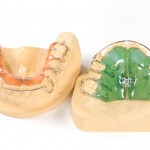
The Clark Twin Block (CTB) is a functional orthodontic appliance. Functional appliances contribute to the correction of Class II malocclusions in growing patients through a combination of dentoalveolar and skeletal effects.
The aim of this study was to investigate whether the addition of a maxillary labial bow has any effect on the inclination of the maxillary incisors and the magnitude of skeletal change that can be achieved in relation to conventional CTB appliance therapy.
Patients (aged 10–14 years at the start of treatment, minimum overjet . 6 mm, molar relationship at least ½ unit Class II) were divided into age- and sex-matched pairs, and randomly allocated to treatment with either a CTB, with or without an upper labial bow. Treatment was continued for 12 months before data collection.
Sixty four patient were randomised with 60 being available for final data collection. The two groups were well matched with respect to age with no significant baseline differences in pre-treatment variables.
They found that both groups experienced a reduction in overjet as a result of maxillary incisor retroclination, mandibular incisor proclination, and forward positioning of the pogonion. Maxillary molar distalisation, mandibular molar mesialisation, and ANB (A point-nasion-B point) reduction also occurred in both groups.
They concluded that:-
The addition of a maxillary labial bow to the CTB has no influence on dentoalveolar or skeletal changes, or on rate of overjet reduction, in relation to appliance therapy.
Yaqoob O, Dibiase AT, Fleming PS, Cobourne MT. Use of the Clark Twin Block functional appliance with and without an upper labial bow: a randomized controlled trial. Angle Orthod. 2011 Aug 18. [Epub ahead of print] PubMed PMID:21848509.
